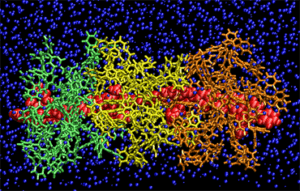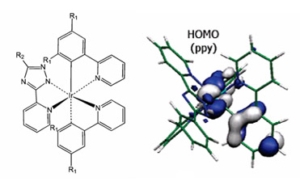Molecular design of materials for opto-electronics
Quantum-chemistry can prove highly valuable to design materials with tailored properties prior to any chemical synthesis or to help in the interpretation of experimental results. In this context, we typically perform calculations (at the semi-empirical or ab initio Hartree Fock, post Hartree-Fock (CI), Density Functional Theory (DFT) and TD-DFT levels) on isolated molecules to establish structure-property relationships and assess for instance the impact of molecular size, electroactive substituents, oxydo-reduction processes, solvent effects.
This fundamental knowledge can then be exploited to design new materials for interest in the field of organic electronics, in particular :
- Conjugated systems with a low optical bandgap for use in solar cells or as infrared emitters;
- Triplet emitters with controlled optical properties;
- Conjugated systems changing their electronic/optical properties upon recognition of an analyte for sensor applications;
- Conjugated systems with low reorganization energies for charge transport.
In a next step, intermolecular interactions are considered to determine in particular the influence of aggregation on optical properties or the ease of charge or excitation transfer between molecules (i.e., electronic couplings used as input for modeling their propagation in supramolecular architectures).


top: Model for the structure of a polyfluorene-based polyrotaxane in water (M. Wikes et al.)
bottom: Iridium-based phosphorescent emitter for OLEDs: chemical structure and shape of the HOMO (I. Avilov et al.)
StructuralCorrelations in the Generation of Polaron Pairs in Low-Bandgap Polymers forPhotovoltaics.
R.Tautz, E. Da Como, T. Limmer, J. Feldmann, H.J. Egelhaaf, E. von Hauff, V.Lemaur, D. Beljonne, S. Yilmaz, I. Dumsch, S. Allard, U. Scherf.
Nature Communications (2012) 3:970.
Graphene Nanoribbons as Low Band Gap Donor Materials for OrganicPhotovoltaics: Quantum Chemical Aided Design
- Osella, A. Narita, M.G. Schwab, Y.Hernandez, X. Feng, K. Müllen, D. Beljonne.
ACSNano 6 (2012) 5539-5548.
Tuning of the Photovoltaic Parameters of MolecularDonors by Covalent Bridging.
- Demeter,V. Jeux, P. Leriche, P. Blanchard, Y. Olivier, J. Cornil, R. Po, J. Roncali.
AdvancedFunctional Materials 23 (2013) 4854-4861.
Atomically Precise Edge Chlorination ofNanographenes and its Applications in Graphene Nanoribbons.
Y.Z. Tan,B. Yang, K. Parvez, A. Narita, S. Osella, D. Beljonne, X. Feng, K. Müllen.
Nature Communications 4 (2013) 2646.
